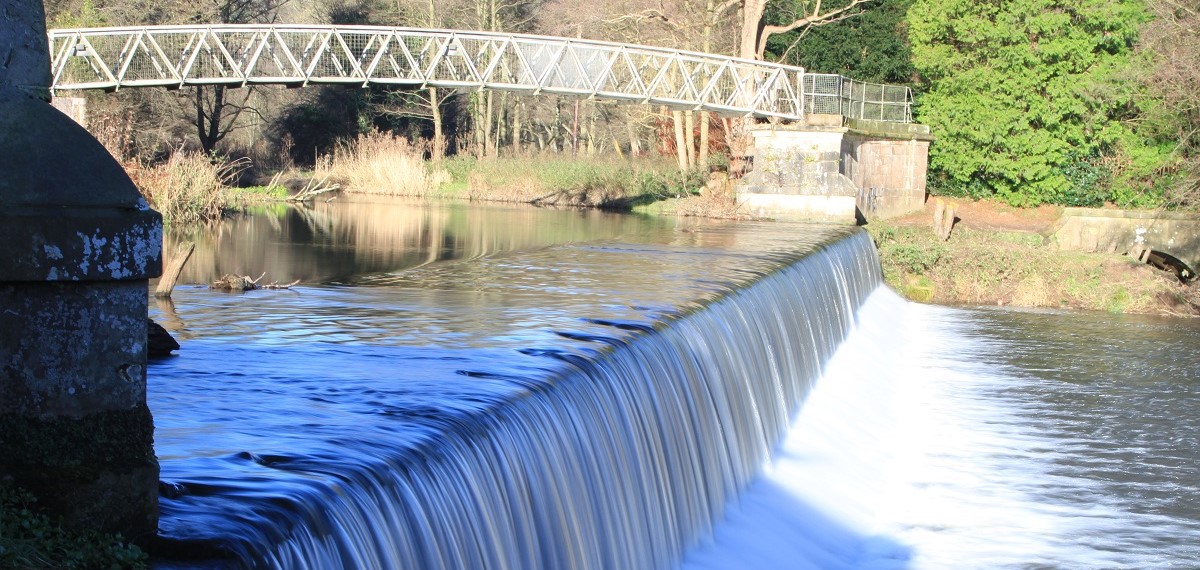Fish pass at iconic Crumpwood weir now in action
 Water once again flows under the 19th century pump house at the Grade II listed Crumpwood weir, after work to create a unique fish pass was completed by the Environment Agency.
Water once again flows under the 19th century pump house at the Grade II listed Crumpwood weir, after work to create a unique fish pass was completed by the Environment Agency.
The work, which involved opening up the previously sealed off channel to the pump house, will help Atlantic Salmon and Brown Trout populate a further seven kilometres of the River Churnet.
Around 240 tonnes of soil and silt was cleared from around the pump house, one of the original pump house turbines removed and cleaned for display and the old oak sluice gates were refurbished. This means the building is beginning to come back into use, while helping to secure the future of salmon in this country.
Crumpwood weir, originally built between 1807 and 1811 was part of the Froghall to Uttoxeter Canal and later used for public water supply. Today it forms an important historic feature in the Churnet Valley’s landscape. But, while it is very pretty to look at, the 2.7 metre difference in the height of the water means it is an impossible barrier for fish and wildlife to pass.
This new fish pass along the River Churnet means seven kilometres of river habitat can now be populated by Atlantic Salmon, Brown Trout, Grayling and Chub to name a few. Helping fish migrate up and down the river means they can find the best habitat to feed, shelter, spawn and grow, helping achieve a resilient and sustainable UK fisheries.
The fish pass was built by the Environment Agency, in partnership with JCB (which loaned the heavy plant equipment) and Staffordshire Wildlife Trust. Local historians, part of Lichfield Waterworks Trust, were also involved, and they helped the project team by providing invaluable advice, supplying historic plans and guidance on how to remove the historic turbine.
As part of the work, the Environment Agency fishery biologists tagged fish found below the weir. They will be monitored by the angling clubs, to see if they arrive above the weir, which will help to evaluate how successful the fish pass has been.
Chris Grzesiok, fisheries, biodiversity and geomorphology expert from the Environment Agency, said:

This has been a wonderful project to be part of. As well as contributing over £330,000 to this project we’ve been able to see how the 19th century pump house was built and with the help of local historians, we’ve been able to repurpose and breathe new life into what was a derelict building. This fish pass is another step towards delivering the 25 year environment plan’s vision of catchments functioning more naturally where wildlife can thrive and migrate freely.
Ken MacDonald, Head of Water Strategy, at South Staffs Water said:

We are always looking for opportunities to work with local community groups and to protect and enhance the biodiversity of the natural environment. We aim to provide a reliable supply of high-quality drinking water for future generations at the same time as allowing wildlife to flourish. This new fish pass at Crumpwood is a practical example of how we can achieve this by working in collaboration with other organisations.
This project was part-funded by the Marine Management Organisation, which contributed £240,000.
Funding from the Marine Management Organisation is part of a co-ordinated and funded programme of projects for 2018/19 with the aim of freeing migration routes of barriers to fish. This project is part of that programme funded by over £1.6 million of European Maritime and Fisheries Funds, which is matched by more than £1 million of Agency/Defra funding and £300,000 of other funds.
Posted: 8 October 2019

